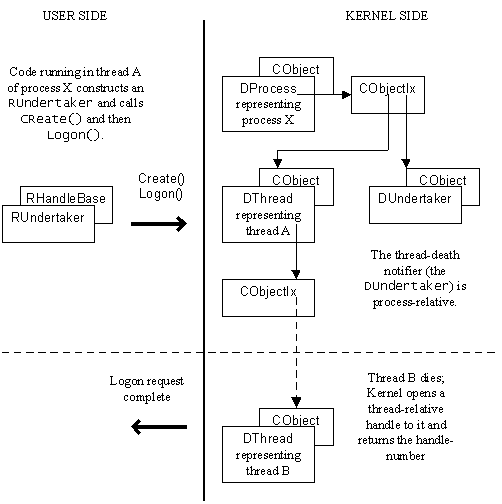How to use a thread-death notifier
Describes the thread-death notifier and provides a code snippet to show you how to use it.
To use a thread-death notifier, a thread which needs to know about the death of other threads:
constructs an
RUndertakerhandle and then calls itsCreate()member function to create the associated Kernel side object. TheRUndertakerhandle is process-relative which means that the handle is not closed if the requesting thread dies.issues a notification request to the thread-death notifier, passing a reference to a
TRequestStatusobject and a reference to aTInt.
When any other thread dies, the requesting thread's request semaphore is
signalled to indicate that the notification request is complete. The TRequestStatus object
supplied by the requesting thread is set to KErrDied.
In addition, the Kernel opens a local thread-relative handle on the dying
thread. (thread-relative, here, means relative to the requesting thread) and
sets the TInt, supplied by the requesting thread, to the
resulting handle-number. The requesting thread can construct an RThread from
this handle-number. The following diagram helps visualise the situation.

Figure: Thread-death notifier
The following code fragments demonstrate this:
{
...
RUndertaker the_undertaker;
TRequestStatus the_status;
TInt the_dyingthread_handle_number;
...
the_undertaker.Create();
the_undertaker.Logon(the_status,the_dyingthread_handle_number);
User::WaitForRequest(the_status);
...
...// prepare for a long wait
...
RThread r;
r.SetHandle(the_dyingthread_handle_number);
...
...// Now have an open thread-relative handle to the
...// dying thread so we can, for example, ...
if (r.ExitReason()==0x666)
{
...
}
...// We have an open handle on the dying thread; the dying thread
...// remains in existence until we close it.
r.Close();
...
}
In practical code, an RUndertaker is used by an active
object.
The RUndertaker handle also offers a LogonCancel() function.
Calling this function, causes the requesting thread's request semaphore to
be signalled and any wait to complete. The TRequestStatus is
set to KErrCancel.
This technique of using an RUndertaker is not guaranteed
to report the death of all threads. In particular, if a second thread dies
while a requesting thread is handling the request completion due to the death
of a first thread (but before it can make another notification request), the
death of this second thread will go unnoticed.